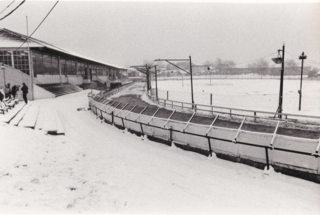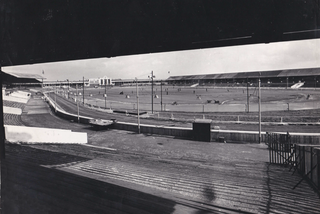
White City Stadium in London, England, was built for the 1908 Summer Olympics. It hosted the finish of the first modern marathon and swimming, speedway, boxing, show jumping, athletics, stock car racing, concerts and a match at the 1966 World Cup.
Harringay Stadium was a major greyhound racing and motorcycle speedway venue in Harringay, north London. It was built and opened in 1927 and closed in 1987.

Catford Stadium was a historic greyhound racing stadium in Catford, a suburb of London.

Hackney Wick Stadium was a greyhound racing and speedway stadium located at Waterden Road in Hackney Wick, London, England.

Glasgow Tigers are a motorcycle speedway team from Glasgow, Scotland. Formed in 1928, the club adopted the Tigers nickname in 1946 and compete in the British SGB Championship. The team race at Ashfield Stadium and celebrated their 75th anniversary in 2021.

West Ham Stadium existed between 1928 and 1972 in Custom House, east London, England, on Prince Regent Lane, near the present-day Prince Regent DLR station.

Wimbledon Stadium, also known as Wimbledon Greyhound Stadium, was a greyhound racing track located in Wimbledon in southwest London, England.
Rye House Stadium was a greyhound racing and speedway venue in Rye Road, Hoddesdon, Hertfordshire. It is situated adjacent to the River Lea Navigation.

Belle Vue Stadium was a greyhound racing track in Belle Vue, Manchester, England, where the first race around an oval track in Britain was held on 24 July 1926. It has also been used for motorcycle speedway, as the home ground of Elite League team Belle Vue Aces from 1988 until 2015, and from 1999 until 2019 for stock car racing and banger racing.

The Greyhound Racing Association was a UK-based private company founded in 1925 and existed until 2019. It was involved in the management of sports venues, notably greyhound racing stadia. The GRA was responsible for introducing Greyhound racing in the United Kingdom and was the largest racing operator for 70 years but diminished when trading as GRA Acquisition from 2005-2019. Despite its name, it was not involved in the administration of greyhound racing itself.

Newcastle Stadium is a greyhound racing and former motorcycle speedway stadium, located on The Fossway, Byker, Newcastle. Racing at the stadium takes place on Tuesdays, Wednesdays, Thursdays and Saturdays. The circumference of the greyhound track is 415 metres. From 1929 until mid-2022, speedway racing took place at the stadium.

Oxford Stadium is a greyhound racing and speedway venue in Oxford, located in Sandy Lane, Cowley.

Leicester Stadium also known as the Blackbird Road Stadium, was a sports stadium on Parker Drive in Leicester. The stadium was initially used for greyhound racing with motorcycle speedway starting there five years later. It was also a venue for BriSCA Formula 1 Stock Cars.

White City Greyhounds was the greyhound racing operation held at White City Stadium in London. The venue was regarded as the sport's primary track during its existence.
The Nottingham speedway team competed in the 1930s, with a home track on Trent Lane, Nottingham.
Fullerton Park was a former speedway and greyhound track in Leeds.
The Marine Gardens was an entertainment complex located in the Portobello area of Edinburgh, Scotland. Opened in 1909 as a pleasure garden and amusement park on the shores of the Firth of Forth, most of its original attractions apart from the ballroom were removed following military use of the site during the First World War. The complex also included a stadium which was used during the interwar period for football, greyhound racing and speedway. It was the home venue of Scottish Football League teams Leith Athletic (1928–1936) and Edinburgh City. The Marine Gardens closed down permanently in 1939 after again being taken over by the military, with the area being redeveloped after the Second World War.

Northumberland County Ground or the Gosforth Greyhound Stadium was a rugby stadium and greyhound racing stadium in Gosforth, Tyne And Wear.
Pennycross Stadium was a greyhound racing and speedway stadium in north Plymouth, Devon.
Portsmouth Greyhound Track (Copnor) also known as the Wessex Stadium was a greyhound racing and motorcycle speedway track in Portsmouth.














